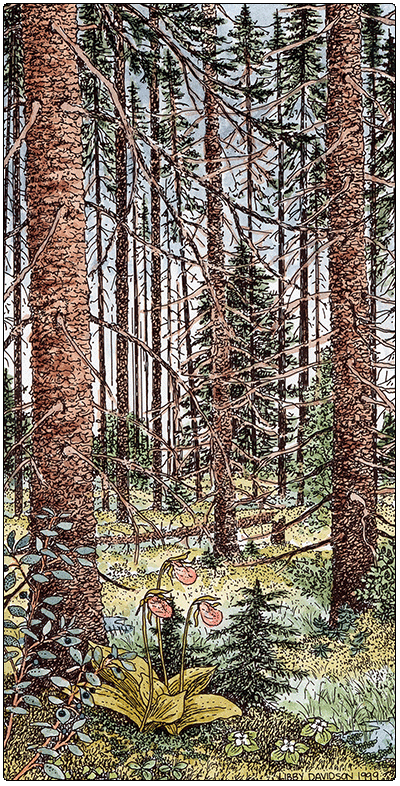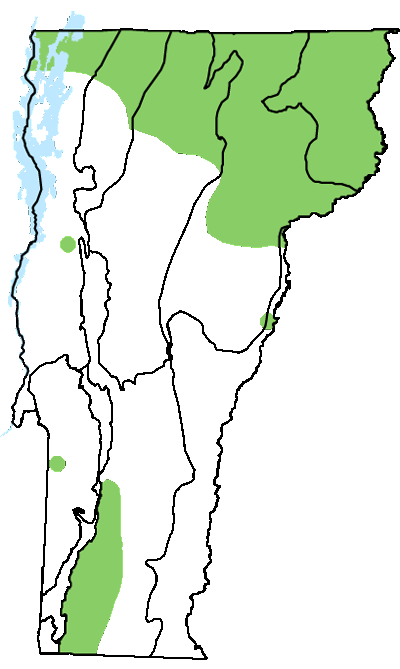Ecology and Physical Setting 
Black Spruce Swamps are dark and cool. The dark-trunked spruce trees grow straight but not especially tall and have many small, dead, low branches. The green, mossy hummocks and hollows are a sharp and lively contrast to the dark tree trunks. Although hummocks and hollows are common, there can be areas of large sphagnum flats, with little microtopography.
Black Spruce Swamps occur in the coldest regions of Vermont, commonly in topographic depressions that receive cold air drainage. They occupy large and small basins with impeded surface water movement. This community is closely related to both Black Spruce Woodland Bog and Spruce-Fir-Tamarack Swamp, and it may occur in association with either or both of these communities. Black Spruce Swamps range in size from 10 to over 100 acres.
The organic soils range in depth from four feet to over 15 feet. They are generally poorly decomposed peats that are made up of wood fragments and sphagnum moss. The peat is saturated throughout the year but there is little standing water. Black Spruce Swamps are one of the most acidic of our swamp types and are found in areas of the state with acidic bedrock or in basins that have developed peat of sufficient depth to isolate the surface of the swamp from any significant mineral enrichment from ground or surface waters.
The primary form of natural disturbance in Vermont’s Black Spruce Swamps is wind, which continually creates canopy gaps and occasionally creates large areas of toppled and tangled trees.
Vegetation
Black spruce dominates the canopy, which varies substantially in the degree of closure from swamp to swamp. Boggier examples have slower-growing, shorter, and more scattered trees, because of lack of nutrients and constant saturation of the peat substrate. Other examples have faster growing, taller trees that form a closed canopy. This results from less boggy conditions, where access to slightly more mineral-enriched water, water movement in the peat, and peat decomposition all provide more nutrients (Bubier 1991). Scattered tamarack may be present in some swamps, typically growing substantially taller than the black spruce. Tall shrubs, which vary from sparse to dense in cover, include mountain holly, wild raisin, and speckled alder. Balsam fir and paper birch may also occur in the tall shrub layer, along with black spruce of all sizes. Low shrubs can be abundant. Common species include bog associates such as Labrador tea, bog laurel, and sheep laurel.

Three-seeded sedge is frequent; other common boreal herbs include bluebead lily, three-leaved Solomon’s seal, goldthread, boreal bog sedge, pink lady’s slipper, pitcher plant, bunchberry, and creeping snowberry. Mosses form a green carpet over the low hummocks and the shallow hollows, most of which do not contain standing water. Sphagnum angustifolium and Sphagnum girgensohnii are abundant in the hollows while Sphagnum magellanicum tops the hummocks. Schreber’s moss is also abundant in the moss carpet.
Wildlife Habitat
In the Northeastern Highlands, Black Spruce Swamps provide breeding habitat for many species of boreal birds—species that are rare in Vermont but are common to our north. These include yellow-bellied flycatcher, black-backed woodpecker, spruce grouse, Canada jay, boreal chickadee, and bay-breasted warbler. The rare American marten and Canada lynx visit Black Spruce Swamps as they range widely, especially in the Nulhegan Basin. In Black Spruce Swamps throughout Vermont, breeding birds include olive-sided flycatcher, yellow-rumped warbler, northern waterthrush, ruby-crowned kinglet, and northern saw-whet owl.
Related Communities
- Spruce-Fir-Tamarack Swamp has a canopy of red spruce, balsam fir, and tamarack along with black spruce. Peat depths tend to be shallower, and there is typically more mineral enrichment than in Black Spruce Swamps.
- Black Spruce Woodland Bog is an open canopy woodland with stunted trees and a dense layer of low heath shrubs. It has well-developed hummocks and hollows, deep peat, and often a more raised peat surface. Nutrients are in shorter supply.
Conservation Status and Management Considerations
Climate change is a threat to this and other cold-climate communities. The best way to maintain the resilience of these swamps is to avoid activities, such as logging, that alter ecological processes. Natural disturbance by wind creates tip-ups of individual trees or small groups of trees. This process leads to the creation of hummocks and hollows and creates canopy openings that provide habitat for some animal species. Even selective logging can disrupt this natural process. Operation of heavy machinery can create ruts that may persist for many years and that alter surface water hydrology.
There are some excellent examples of this community protected on state-owned land.
Distribution/Abundance 
Black Spruce Swamps are found throughout the colder regions of Vermont, where they are commonly associated with bogs in cold depressions. Vermont’s Black Spruce Swamps are a southern extension of similar communities that are abundant in the boreal forest zone found in the high latitudes of North America.
Characteristic Plants
Trees
Abundant Species
Black spruce – Picea mariana
Occasional to Locally Abundant Species
Tamarack – Larix laricina
Balsam fir – Abies balsamea
Red spruce – Picea rubens
Paper birch – Betula papyrifera
Red maple – Acer rubrum
Shrubs
Abundant Species
Mountain holly – Ilex mucronata
Wild raisin – Viburnum nudum var. cassinoides
Labrador tea – Rhododendron groenlandicum
Bog laurel – Kalmia polifolia
Occasional to Locally Abundant Species
Low sweet blueberry – Vaccinium angustifolium
Velvetleaf blueberry – Vaccinium myrtilloides
Sheep laurel – Kalmia angustifolia
Rhodora – Rhododendron canadense
Black huckleberry – Gaylussacia baccata
Black chokeberry – Aronia melanocarpa
Speckled alder – Alnus incana
Herbs
Abundant Species
Three-seeded sedge – Carex trisperma
Goldthread – Coptis trifolia
Creeping snowberry – Gaultheria hispidula
Occasional to Locally Abundant Species
Boreal bog sedge – Carex magellanica
Hoary sedge – Carex canescens
Bluebead lily – Clintonia borealis
Three-leaved false Solomon’s seal – Maianthemum trifolium
Pink lady’s slipper – Cypripedium acaule
Bunchberry – Cornus canadensis
Pitcher plant – Sarracenia purpurea
Tawny cottongrass – Eriophorum virginicum
Cinnamon fern – Osmundastrum cinnamomeum
Bryophytes
Abundant Species
Moss – Sphagnum girgensohnii
Moss – Sphagnum angustifolium
Schreber’s moss – Pleurozium schreberi
Occasional to Locally Abundant Species
Moss – Sphagnum magellanicum
Moss – Sphagnum capillifolium
Moss – Sphagnum wulfianum
Moss – Sphagnum russowii
Moss – Sphagnum fallax
Bog broom moss – Dicranum undulatum
Knight’s plume moss – Ptilium crista-castrensis
Rare and Uncommon Plants
Moose dung moss – Splachnum ampullaceum
Dwarf mistletoe – Arceuthobium pusillum
Mountain cranberry – Vaccinium vitis-idaea
Associated Animals
Red squirrel – Tamiasciurus hudsonicus
Southern red-backed vole – Myodes gapperi
Olive-sided flycatcher – Contopus cooperi
Yellow-rumped warbler – Setophaga coronata
Nashville warbler – Oreothlypis ruficapilla
Northern parula – Parula americana
Magnolia warbler – Dendroica magnolia
Ruby-crowned kinglet – Regulus calendula
Northern waterthrush – Parkesia noveboracensis
Rare and Uncommon Animals
American marten – Martes americana
Canadian lynx – Lynx canadensis
Yellow-bellied flycatcher – Empidonax flaviventris
Black-backed woodpecker – Picoides arcticus
Spruce grouse – Falcipennis canadensis
Canada jay – Perisoreus canadensis
Bay-breasted warbler – Setophaga castanea
Boreal chickadee – Poecile hudsonicus
Northern saw-whet owl – Aegolius acadicus
Rusty blackbird – Euphagus carolinus
Kennedy’s emerald – Somatochlora kennedyi
Places to Visit
Alburgh Dunes State Park, Alburgh, Vermont Department of Forests, Parks, and Recreation
Yellow Bogs, Lewis, Silvio O. Conte National Fish and Wildlife Refuge, U.S. Fish and Wildlife Service
Wenlock Wildlife Management Area, Ferdinand, Vermont Fish and Wildlife Department (VFWD)
Victory Basin Wildlife Management Area, Victory, VFWD
